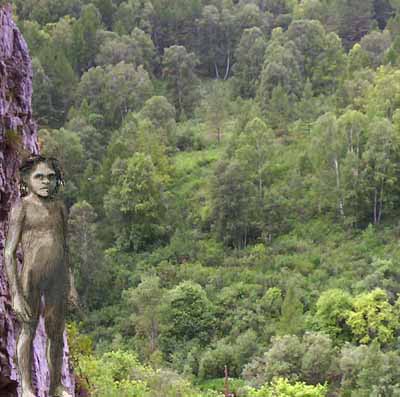

The Denisova hominin is the name given to the remains of a member of the genus Homo which may be a previously unknown species based on an analysis of its mitochondrial DNA (mtDNA). In March 2010, discovery was announced of bone fragments of a juvenile that lived about 41,000 years ago found in Denisova Cave (Altai Krai, Russia) - a region also inhabited at about the same time by Neanderthals and modern humans.
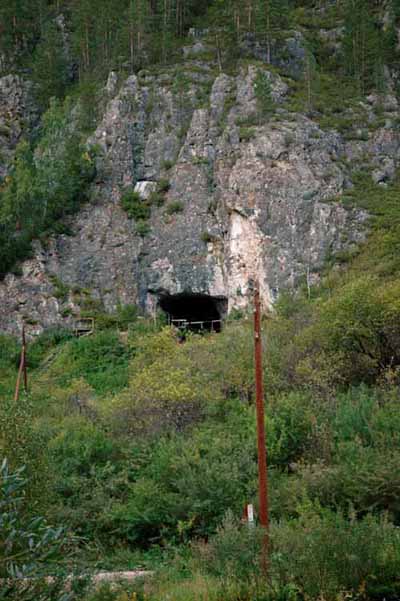
The mtDNA of the Denisova hominin is distinct from the mtDNAs of Neanderthals and modern humans. In December 2010, an international team of scientists determined sequence from the nuclear genome of this group (known as the Denisovans) from this finger bone. Based on their analysis, this group was related to the Neanderthals and interbred with the ancestors of modern Melanesians.
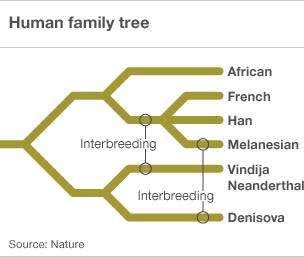
Little is known of the anatomical features of the individual in question since the only physical remains discovered thus far are the finger bone from which only mitochondrial genetic material was gathered. The Siberian bone's mtDNA differs from that of modern humans by 385 bases (nucleotides) in the mtDNA strand out of approximately 16,500, whereas the difference between modern humans and Neanderthals is around 202 bases.
In contrast, the difference between chimpanzees and modern humans is approximately 1,462 mtDNA base pairs. Analysis of the specimen's nuclear DNA shows it to be a branch of the Neanderthal lineage. Even though the Denisova hominin's mtDNA lineage predates the divergence of modern humans and Neanderthals, coalescent theory does not preclude a more recent divergence date for her nuclear DNA.
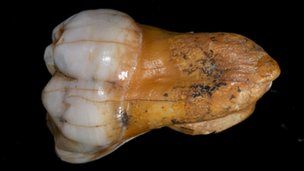
In 2008, Russian archeologists working at the site of Denisova Cave in the Altai Mountains of Siberia uncovered a small bone fragment from the fifth finger of a juvenile hominin, dubbed the "X-woman" (referring to the maternal descent of mitochondrial DNA), or the Denisova hominin. Artifacts, including a bracelet, excavated in the cave at the same level were carbon dated to around 40,000 BC.
A team of scientists sequenced mtDNA extracted from the fragment. Because of the cool climate in the location of the Denisova Cave, the discovery benefited from DNA's ability to survive for longer periods at lower temperatures. The analysis indicated that modern humans, Neanderthals, and the Denisova hominin last shared a common ancestor around 1 million years ago. Modern humans are known to have overlapped with Neanderthals in Europe for more than 10,000 years, and the discovery raises the possibility that Neanderthals, modern humans and the Denisovan hominin may have co-existed.
The DNA analysis further indicated that this new hominin species was the result of an early migration out of Africa, distinct from the later out-of-Africa migrations associated with Neanderthals and modern humans, but also distinct from the earlier African exodus of Homo erectus.
Professor Chris Stringer, human origins researcher at London's Natural History Museum and one of the leading proponents of the recent single-origin hypothesis, remarked: "This new DNA work provides an entirely new way of looking at the still poorly understood evolution of humans in central and eastern Asia." Paabo noted that the existence of this distant branch creates a much more complex picture of humankind during the Late Pleistocene.
In 2010, a second paper from the Svante Paabo group reported the prior discovery, in 2000, of a 3rd upper molar from a young adult, dating from about the same time (the finger was from level 11 in the cave sequence, the tooth from level 11.1).
The tooth differed in several aspects from those of Neanderthal, while having archaic characteristics similar to the teeth of Homo erectus. They again performed mitochondrial DNA analysis on the tooth and found it to have a different but similar sequence to that from the bone, indicating a divergence time about 7500 years before, and suggesting it belonged to a different individual from the same population.
1 million-year-old skull from China holds clues to the origins of Neanderthals, Denisovans and humans Live Science - September 25, 2025
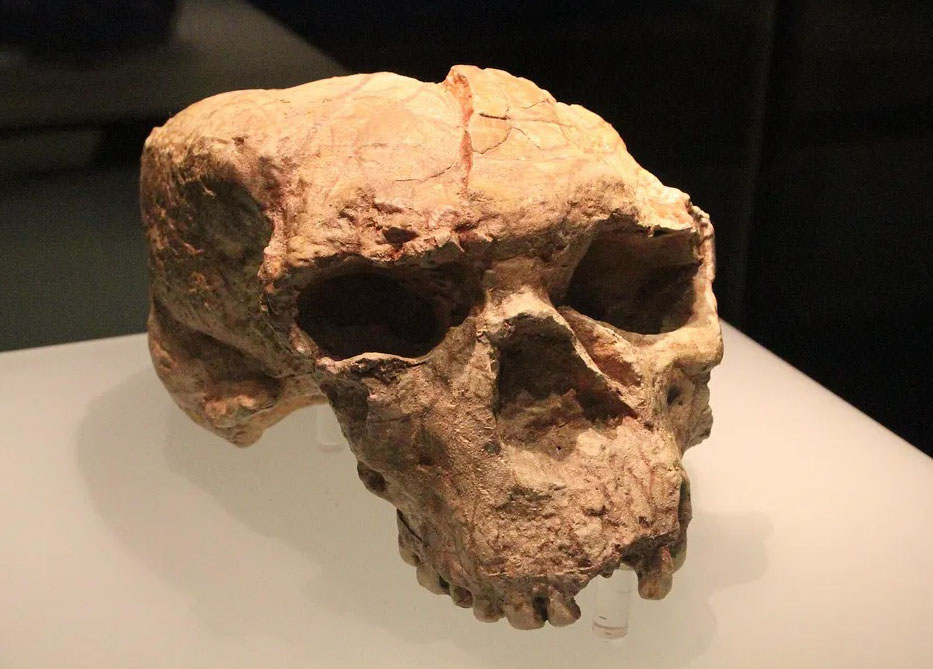
Researchers have virtually reconstructed a crushed and distorted 1 million-year-old human skull discovered in China. The newly restored cranium may have belonged to a relative of the mysterious Denisovans and provides clues to the rapid evolution of Homo sapiens in Asia.
The first Americans had Denisovan DNA. And it may have helped them survive. Live Science - August 22, 2025
The first people to step foot in the Americas were harboring a sliver of DNA from two extinct Eurasian human groups: the Neanderthals and the Denisovans, a new study finds. This genetic relic could have helped the earliest Americans fight diseases they encountered in their new environment, the researchers proposed. Everyone alive today is "a result of like three different species coming together,
Mysterious Denisovan interbreeding shaped the humans we are today Science Daily - August 14, 2025
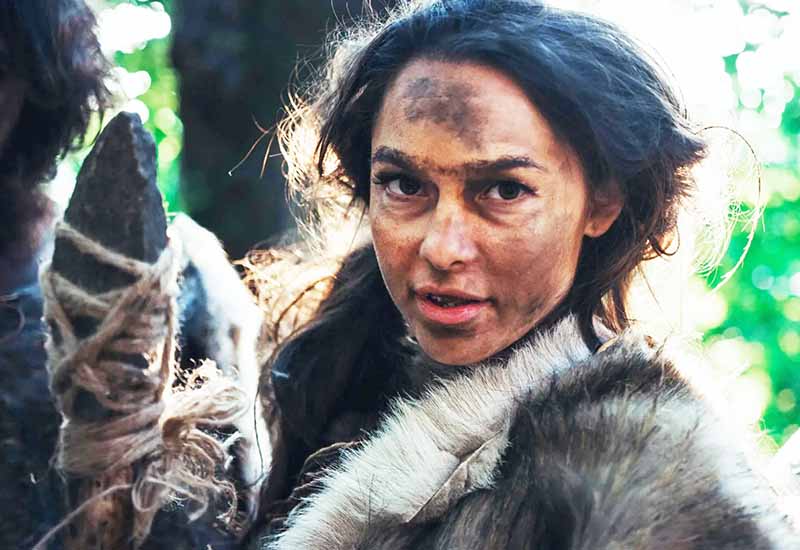
Researchers think that members of the most recently identified “hominin” group (the Denisovans) mixed with early modern humans and passed along parts of their DNA. Evidence points to several separate interbreeding events, each leaving a genetic imprint that influenced the course of human history.
Scientists have determined that a giant skull from an ancient human relative named the "Dragon Man" is actually Denisovan. Live Science - June 18, 2025
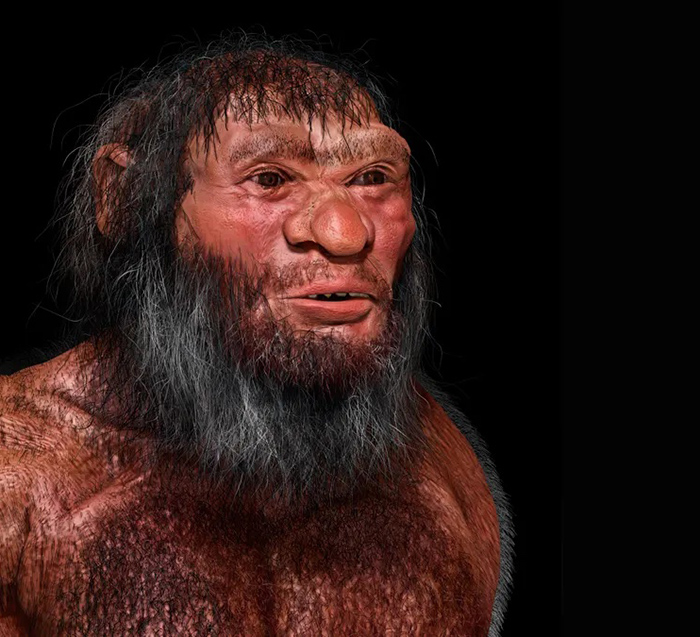
Using cutting-edge DNA analysis, scientists have uncovered the true identity of an ancient human relative nicknamed the "Dragon Man." The mystery began with a giant, human-like skull discovered by a Chinese laborer in Harbin City, China, in 1933. In 2018, the man's family recovered the Harbin skull, which the laborer had buried in a well, and donated it to science. The enormous cranium features a long, low braincase and a massive brow ridge, along with a broad nose and big eyes. Based on the skull's unusual shape and size, experts gave it a new species name - Homo longi, or "Dragon Man" - in 2021.
Researchers have determined that a mysterious jawbone discovered on the seafloor off the coast of Taiwan was Denisovan, proving that the archaic humans were distributed widely over Asia. Live Science - May 6, 2025
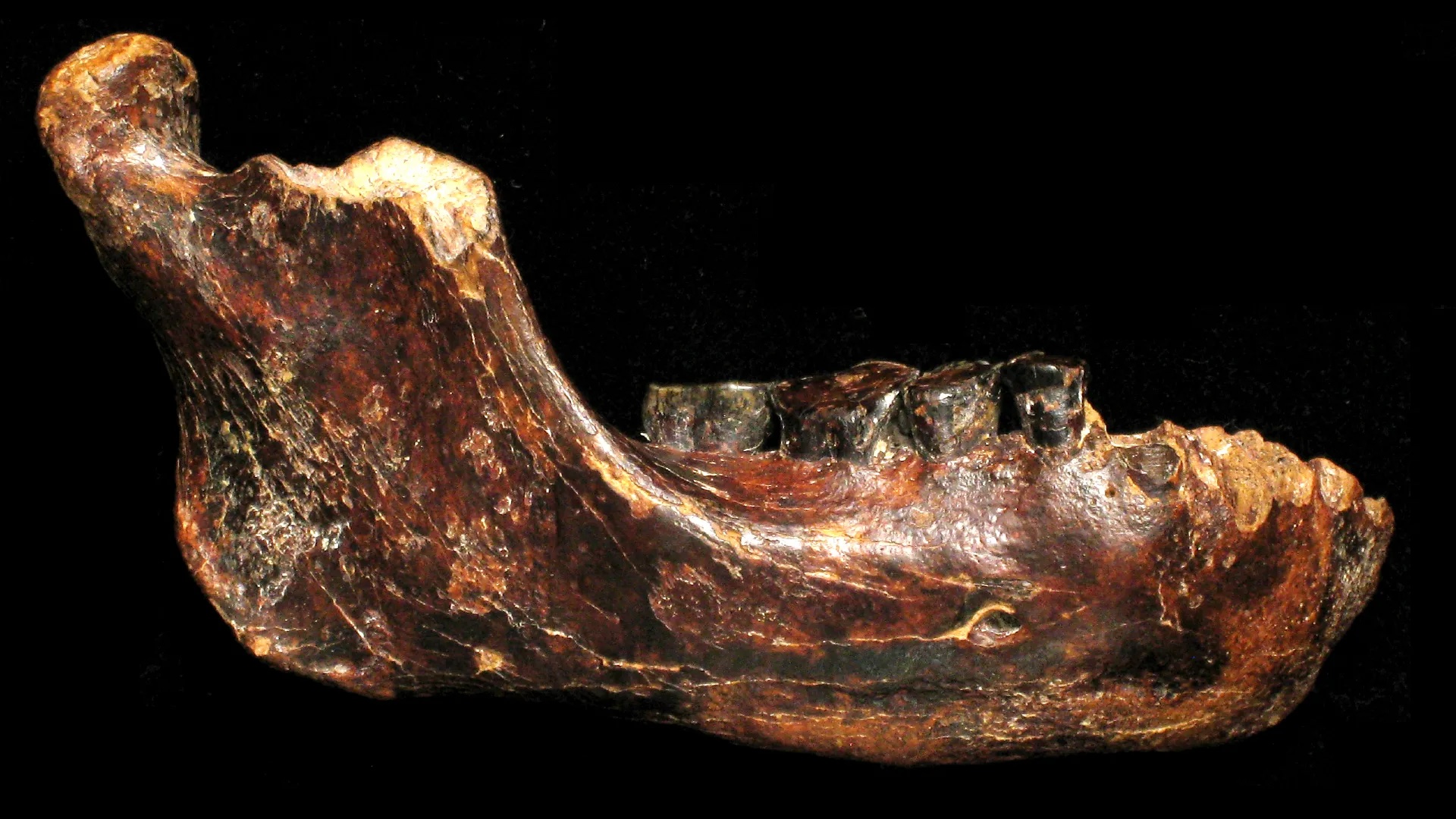
A mysterious human jaw discovered off the coast of Taiwan doesn't belong to our species or Neanderthals, but to another extinct relative, Denisovans.
First Denisovan Fossil Discovered in Taiwan Reveals Secrets of Our Ancient Relatives Science Alert - April 11, 2025
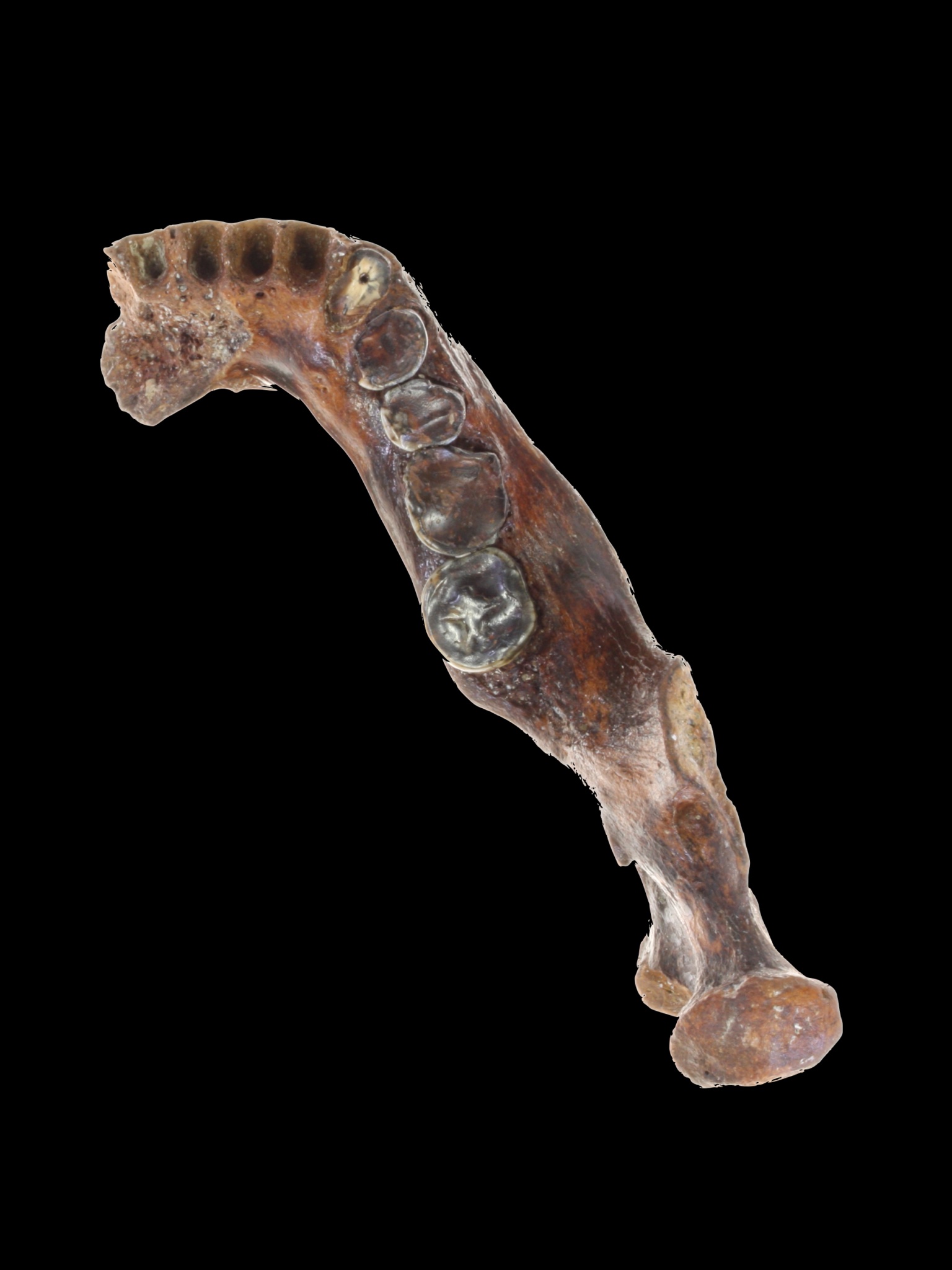
Analysis of a perfect jawbone found in Taiwan has given us new clues to the Denisovans, an enigmatic people with whom our ancestors had relations. Once upon a time, Homo sapiens wasn't the only human species walking the planet. We shared this world with multiple long-lost relatives, a history of intermingling written in our genomes.
Humans, But Not Quite: Denisova Cave Shows The Strange Backstory Of Us IFL Science - April 15, 2023
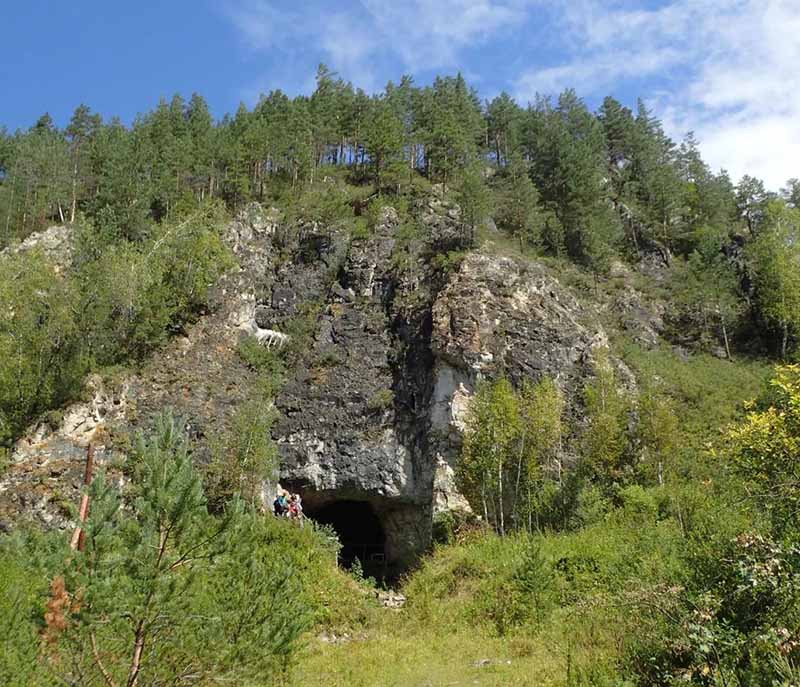
The entrance to Denisova Cave, the famous site in southern Siberia where remains of both Neanderthals and the Denisovans have been found. The Denisova Cave is the site of one of the most important crossroads in the history of humans. Not only does the cave contain evidence of Homo sapiens and Neanderthals, but for several years it was the only place where remains were found of our lesser-known cousins: the Denisovans. The cave even features remains of related hybrids, indicating this mysterious location was linked to the inter-species mingling that still lives on in our genome today.
Ancient tooth of mysterious Denisovan girl possibly found Live Science - May 17, 2022
The discovery of an ancient molar - a tooth that likely belonged to young girl who lived up to 164,000 years ago in a cave in what is now Laos - is new evidence that the mysterious human lineage dubbed the Denisovans, previously known only from caves in Siberia and China, also lived in Southeast Asia
Ancient Tooth Once Belonged to The Mysterious Denisovans, Scientists Think Science Alert - May 17, 2022
Deep in the forests of Laos, in a cave in the Annamite Mountains, lay a single child's tooth. That tooth an unassuming molar could be from a mysterious species of human we know little about, and of which few remains are known to exist. The tooth, from the Tam Ngu Hao 2 cave, most likely represents a Denisovan. Denisovans are an extinct species of human first discovered when an analysis of a child's finger bone found in a Siberian cave in 2008 was determined to not be a fit for any known human species. From what we can tell from specimens dated almost all the way back to 200,000 years ago, Denisovans share close genetic similarities with Neanderthals.
Our Extinct Cousins the Denisovans Reached 'The Roof of The World' a Long Time Before Homo Sapiens Science Alert - December 13, 2021
If it wasn't for an extinct relative of modern humans known as the Denisovans, some researchers suspect our own species might never have made their home on the highest and largest plateau in the world. The Tibetan Plateau, sometimes called the Himalayan Plateau, is nicknamed 'the roof of the world' because it sits, on average, 4,000 meters (13,000 feet) above sea level. This vast sweep of elevated land, which covers most of Tibet, along with parts of China, India, Pakistan, and several other countries in the region, is usually considered one of the last places that Homo sapiens settled permanently. Studies suggest there have been periods of occupation by various ancestors taking place over the past 160,000 years, but gaps in the record are hard to interpret.
Scientists have unearthed the oldest fossils to date of the mysterious human lineage known as the Denisovans. With these 200,000-year-old bones, researchers have also for the first time discovered stone artifacts linked to these extinct relatives of modern humans Live Science - November 29, 2021
irst identified a little more than a decade ago, the Denisovans - an extinct branch of the human family tree - are the closest known relatives of modern humans, along with Neanderthals. Analysis of DNA extracted from Denisovan fossils suggests they might have once been widespread across continental Asia, island Southeast Asia and Oceania, and revealed that at least two distinct groups of Denisovans interbred with ancestors of modern humans. Until now, scientists had only discovered half a dozen Denisovan fossils. Five were unearthed in Denisova Cave in Siberia, and one was found in a holy site in China
DNA from an ancient, unidentified ancestor was passed down to humans living today PhysOrg - August 6, 2020
A new analysis of ancient genomes suggests that different branches of the human family tree interbred multiple times, and that some humans carry DNA from an archaic, unknown ancestor. Roughly 50,000 years ago, a group of humans migrated out of Africa and interbred with Neanderthals in Eurasia. But that's not the only time that our ancient human ancestors and their relatives swapped DNA.
The sequencing of genomes from Neanderthals and a less well-known ancient group, the Denisovans, has yielded many new insights into these interbreeding events and into the movement of ancient human populations. In the new paper, the researchers developed an algorithm for analyzing genomes that can identify segments of DNA that came from other species, even if that gene flow occurred thousands of years ago and came from an unknown source. They used the algorithm to look at genomes from two Neanderthals, a Denisovan and two African humans. The researchers found evidence that 3 percent of the Neanderthal genome came from ancient humans, and estimate that the interbreeding occurred between 200,000 and 300,000 years ago. Furthermore, 1 percent of the Denisovan genome likely came from an unknown and more distant relative, possibly Homo erectus, and about 15% of these "super-archaic" regions may have been passed down to modern humans who are alive today.
The new findings confirm previously reported cases of gene flow between ancient humans and their relatives, and also point to new instances of interbreeding. Given the number of these events, the researchers say that genetic exchange was likely whenever two groups overlapped in time and space. Their new algorithm solves the challenging problem of identifying tiny remnants of gene flow that occurred hundreds of thousands of years ago, when only a handful of ancient genomes are available. This algorithm may also be useful for studying gene flow in other species where interbreeding occurred, such as in wolves and dogs.
Researchers have provided the first glimpse of what an ancient group of humans looked like BBC - September 19, 2019
Denisovan remains were discovered in 2008 and human evolution experts have become fascinated with the group that went extinct around 50,000 years ago. One of the biggest questions had been over their appearance, with no full sketches of the Denisovan drawn up.
But now a team of researchers have produced reconstructions of our long-lost relatives. BBC - September 19, 2019
Extinct Denisovan Woman Gets Her First Portrait Thanks to DNA from Her Pinky Bone Live Science - September 19, 2019
As recently as 15,000 years ago, humans shared their caves with another group of upright apes called the Denisovans. The two hominins were genetically distinct, splitting from their nearest common ancestor more than 500,000 years earlier, but they were physically close. Humans and Denisovans mated - probably a lot - over a range that spanned from Siberia to Southeast Asia, leaving a scant genetic lineage that's still detectable in some human populations today.
Fossil find suggests Denisovan fingers looked more like modern human fingers than Neanderthal fingers PhysOrg - September 5, 2019
Prior research has shown that approximately 800,000 years ago, Neanderthals and modern humans diverged from some unknown common ancestor. Then approximately 400,000 years ago, another split occurred - a group that led to the Denisovans diverging from Neanderthals. After the split, the group that became the Denisovans moved into Asia, while Neanderthals remained mostly in Europe. Each of the three groups evolved unique characteristics, but they remained similar enough to interbreed on occasion. Interestingly, study of modern human DNA has found evidence of a split within the Denisovans as well, in later years.
Denisovans: Primitive humans lived at high altitudes BBC - May 1, 2019
Scientists have found evidence that an ancient species of human called Denisovans lived at high altitudes in Tibet.
The ability to survive in such extreme environments had previously been associated only with our species - Homo sapiens.
The ancient ancestor seems to have passed on a gene that helps modern people cope at high elevations.
First hominins on the Tibetan Plateau were Denisovans - Denisovan mandible likely represents the earliest hominin fossil on the Tibetan Plateau Science Daily - May 1, 2019
So far Denisovans were only known from a small collection of fossil fragments from Denisova Cave in Siberia. A research team now describes a 160,000-year-old hominin mandible from Xiahe in China. Using ancient protein analysis the researchers found that the mandible's owner belonged to a population that was closely related to the Denisovans from Siberia. This population occupied the Tibetan Plateau in the Middle Pleistocene and was adapted to this low-oxygen environment long before Homo sapiens arrived in the region.
Ancient DNA reveals new branches of the Denisovan family tree PhysOrg - April 12, 2019
It's widely accepted that anatomically modern humans interbred with their close relatives, the Neanderthals and Denisovans, as they dispersed out of Africa. But a study examining DNA fragments passed down from these ancient hominins to modern people living in Island Southeast Asia and New Guinea now suggests that the ancestry of Papuans includes not just one but two distinct Denisovan lineages, which had been separated from each other for hundreds of thousands of years. In fact, the researchers suggest, one of those Denisovan lineages is so different from the other that they really should be considered as an entirely new archaic hominin species.
First ever piece of a Denisovan skull is discovered in the Siberian cave where the remains of four other members of our ancient relatives have been found Daily Mail - March 4, 2019
t is being heralded as a dramatic contribution to the handful of known samples from one of the most obscure branches of the hominin family tree.
Artificial Intelligence Study of Human Genome Finds Unknown Human Ancestor Smithsonian - February 9, 2019
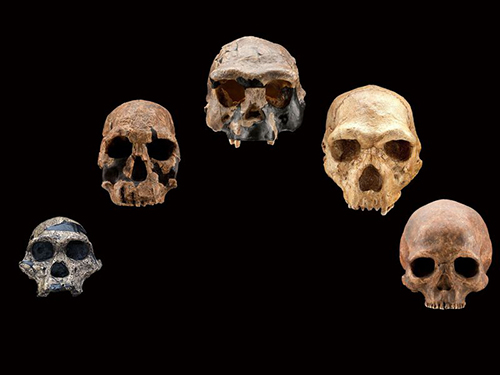
The genetic footprint of a 'ghost population' may match that of a Neanderthal and Denisovan hybrid fossil found in Siberia
Inside the Siberian cave where a hybrid Neanderthal love child was found: Incredible photos show where the teenage daughter of a Neanderthal mother and a Denisovan father lived 50,000 years ago Daily Mail - August 28, 2018
Stunning images reveal the inside of a Siberian cave where an amazing inter-species love child known as Denny lived more than 50,000 years ago. The remarkable girl, who was believed to be aged around 13, was not Homo sapiens. Instead, DNA analysis of a small fragment of bone has revealed she was the product of a sexual liaison between a Neanderthal mother and a father from another now-extinct early human grouping, known as the Denisovans. Other discoveries from the cave where Denny lived – which is found in the limestone foothills of the Altai Mountains – have proven the Denisovans were more advanced than both Homo sapiens and Neanderthals.
Cave girl was half Neanderthal, half Denisovan BBC - August 22, 2018
Once upon a time, two early humans of different ancestry met at a cave in Russia. Some 50,000 years later, scientists have confirmed that they had a daughter together. DNA extracted from bone fragments found in the cave show the girl was the offspring of a Neanderthal mother and a Denisovan father. The discovery, reported in Nature, gives a rare insight into the lives of our closest ancient human relatives.
Neanderthals and Denisovans were humans like us, but belonged to different species.
Neanderthals and Denisovans Mated, New Hybrid Bone Reveals Live Science - August 22, 2018
The closest known extinct relatives of modern humans were the thick-browed Neanderthals and the mysterious Denisovans. Now, a bone fragment from a Siberian cave, perhaps from a teenage girl, has revealed the first known hybrid of these groups, a new study concludes. The finding confirms interbreeding that had been only hinted at in earlier genetic studies. A number of now-extinct human lineages not only lived alongside modern humans but even interbred with them, leaving traces of their DNA in the modern human genome. These lineages included the stocky Neanderthals, as well as the enigmatic Denisovans, known only from a few teeth and bones unearthed in Denisova Cave in the Altai Mountains. Archaeological excavations have revealed that Neanderthals and Denisovans coexisted in Eurasia, with Neanderthal bones ranging from 200,000 to 40,000 years old unearthed mostly in western Eurasia and Denisovans so far only known from fossils ranging from 200,000 to 30,000 years old found in eastern Eurasia. Prior work unearthed Neanderthal remains in Denisova Cave, raising questions on how closely they interacted.
Neanderthal mother, Denisovan father! Hybrid fossil - Newly-sequenced genome sheds light on interactions between ancient hominins Science Daily - August 22, 2018
Up until 40,000 years ago, at least two groups of hominins inhabited Eurasia -- Neanderthals in the west and Denisovans in the east. Now, researchers have sequenced the genome of an ancient hominin individual from Siberia, and discovered that she had a Neanderthal mother and a Denisovan father.
Modern humans interbred with mysterious Denisovans at least twice after leaving Africa 200,000 years ago (and millions of people today still have their DNA) Daily Mail - March 15, 2018
Modern humans co-existed and interbred not only with Neanderthals, but also with another species of archaic humans, the mysterious Denisovans. While developing a new genome-analysis method for comparing whole genomes between modern human and Denisovan populations, researchers unexpectedly discovered two distinct episodes of Denisovan genetic intermixing, or admixing, between the two. This suggests a more diverse genetic history than previously thought between the Denisovans and modern humans.
A world map of Neanderthal and Denisovan ancestry in modern humans Science Daily - March 28, 2016
Most non-Africans possess at least a little bit Neanderthal DNA. But a new map of archaic ancestry suggests that many bloodlines around the world, particularly of South Asian descent, may actually be a bit more Denisovan, a mysterious population of hominids that lived around the same time as the Neanderthals. The analysis also proposes that modern humans interbred with Denisovans about 100 generations after their trysts with Neanderthals.
Do we owe our thick hair and tough skin to Neanderthals? Daily Mail - March 28, 2016
World map of prehistoric ancestry shows how interbreeding has changed and even helped modern humans. The study has unearthed some surprising new benefits these illicit encounters have gifted to modern humans living today.For example genetic variants inherited from Denisovans appear to have given some people in south Asia a better ability to detect subtle scents and helped others to survive at high altitudes.
Ancient Denisovan DNA excavated in modern Pacific Islanders Science Daily - March 19, 2016
Archaic Denisovan and Neanderthal DNA that persists in modern Pacific islanders of Melanesia, far from the Siberian cave where Denisovan fossils have been found, is a source of information about early human history. Equally informative are genome regions where DNA from extinct, human-like species has vanished and been replaced with sequences unique to people. These large regions have genes for brain development, language and brain cell signalling. Retained archaic DNA in human genomes may confer infection-fighting advantages.
DNA analysis of Denisovan molars offers more clues about ancient human relative PhysOrg - November 18, 2015
A team of researchers with members from Germany, Canada and Russia has conducted a DNA analysis of two molars found in the Denisova caves in Siberia shedding more light on the origins of the Denisovans - a hominin species that lived or at least visited Siberia approximately a hundred thousand years ago.
Researchers create methylation maps of Neanderthals and Denisovans, compare them to modern humans PhysOrg - April 18, 2014
A team of Israeli, Spanish and German researchers has for the first time created a map of gene expression in Neanderthals and Denisovans and has compared them with modern humans. In their paper published in the journal Science, the team describes how they applied epigentics to the study of our two closest known ancestors and discovered variations that might account for their differences in body shape and susceptibility to some modern neurological diseases.
Scientists know that it's not just our DNA structure that determines how we look and what we're capable of doing, there's another factor involved the expression of our genes they can be turned on or off at some point, allowing or preventing certain traits from developing. This process is known as DNA methylation where methyl group chemicals attach to DNA and prevent them from behaving as they would otherwise. In this new effort, the researchers looked at methylation in Neanderthals and Denisovans to learn more about how they might have been different from us. Studying methylation in preserved fossils involves noting the way the methyl chemical cytosine decays over long periods of time. Unmethylated cytosines decay to one type of chemical while unmethylated cyctones decay to another. By measuring the amounts of the two resultant chemicals found in fossilized bone fragments, the researchers were able to create methylation maps of Neanderthals and Denisovans, which they then compared with similar maps for modern humans.
Neanderthal Genome Shows Early Human Interbreeding Science Daily - December 19, 2013
The most complete sequence to date of the Neanderthal genome, using DNA extracted from a woman's toe bone that dates back 50,000 years, reveals a long history of interbreeding among at least four different types of early humans living in Europe and Asia at that time
Leg bone gives up oldest human DNA BBC - December 4, 2013
The discovery of DNA in a 400,000-year-old human thigh bone will open up a new frontier in the study of our ancestors. That's the verdict cast by human evolution experts on an analysis in Nature journal of the oldest human genetic material ever sequenced. The femur comes from the famed "Pit of Bones" site in Spain, which gave up the remains of at least 28 ancient people.
Oldest Hominin DNA Sequenced: Mitochondrial Genome of a 400,000-Year-Old Hominin from Spain Decoded Science Daily - December 4, 2013
Using novel techniques to extract and study ancient DNA researchers at the Max Planck Institute for Evolutionary Anthropology in Leipzig, Germany, have determined an almost complete mitochondrial genome sequence of a 400,000-year-old representative of the genus Homo from Sima de los Huesos, a unique cave site in Northern Spain, and found that it is related to the mitochondrial genome of Denisovans, extinct relatives of Neandertals in Asia. DNA this old has until recently been retrieved only from the permafrost.
Oldest Human DNA Reveals Mysterious Branch of Humanity Live Science - December 4, 2013
The oldest known human DNA found yet reveals human evolution was even more confusing than thought, researchers say. The DNA, which dates back some 400,000 years, may belong to an unknown human ancestor, say scientists. These new findings could shed light on a mysterious extinct branch of humanity known as Denisovans, who were close relatives of Neanderthals, scientists added. Although modern humans are the only surviving human lineage, others once strode the Earth. These included Neanderthals, the closest extinct relatives of modern humans, and the relatively newfound Denisovans, who are thought to have lived in a vast expanse from Siberia to Southeast Asia. Research shows that the Denisovans shared a common origin with Neanderthals but were genetically distinct, with both apparently descending from a common ancestral group that had diverged earlier from the forerunners of modern humans.
Ancient humans, dubbed 'Denisovans', interbred with us BBC - December 23, 2010
In the same 2010 paper, the authors report the isolation and sequencing of nuclear DNA from the Denisova finger bone. This specimen showed an unusual degree of DNA preservation and low level of contamination. They were able to achieve near-complete genomic sequencing, allowing a detailed comparison with Neanderthal and modern humans. From this analysis, they concluded that in spite of the apparent divergence of their mitochondrial sequence, the Denisova population along with Neanderthal shared a common branch from the lineage leading to modern African humans. They suggest that the divergence of the Denisova mtDNA results either from the persistence of a lineage purged from the other branches of humanity through genetic drift or else an introgression from an older hominin lineage.
In addition to genetic studies linking approximately 4% of non-African modern human DNA to Neanderthals, these tests comparing the Denisova hominin genome with those of modern humans from Africa, Europe, East Asia and Melanesia showed that between 4% and 6% of the genome of Melanesians derives from a Denisovan population, introduced after the lineage leading to Melanesians diverged from that leading to other Eurasians.